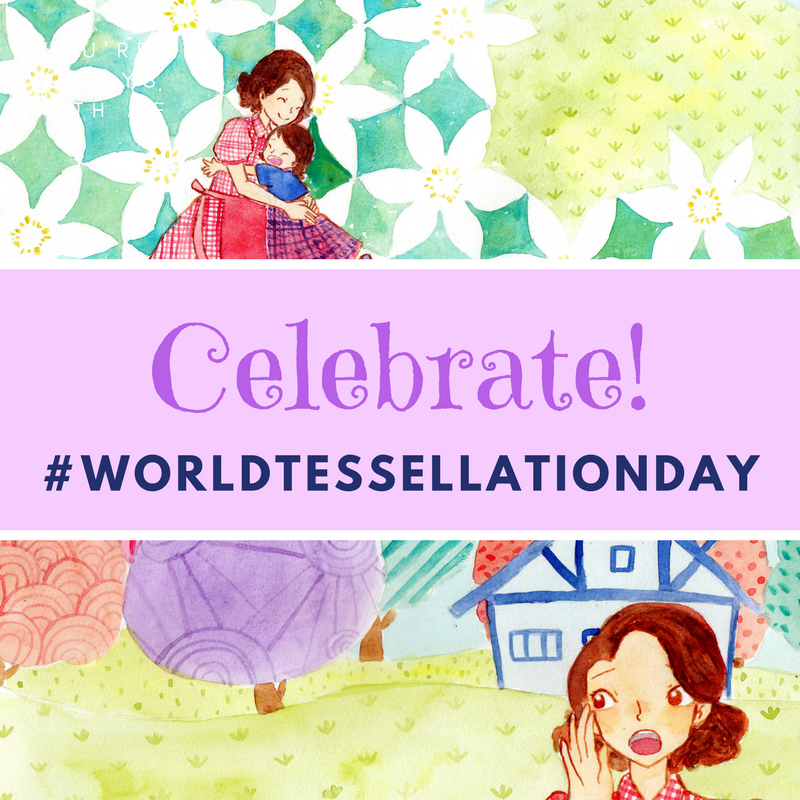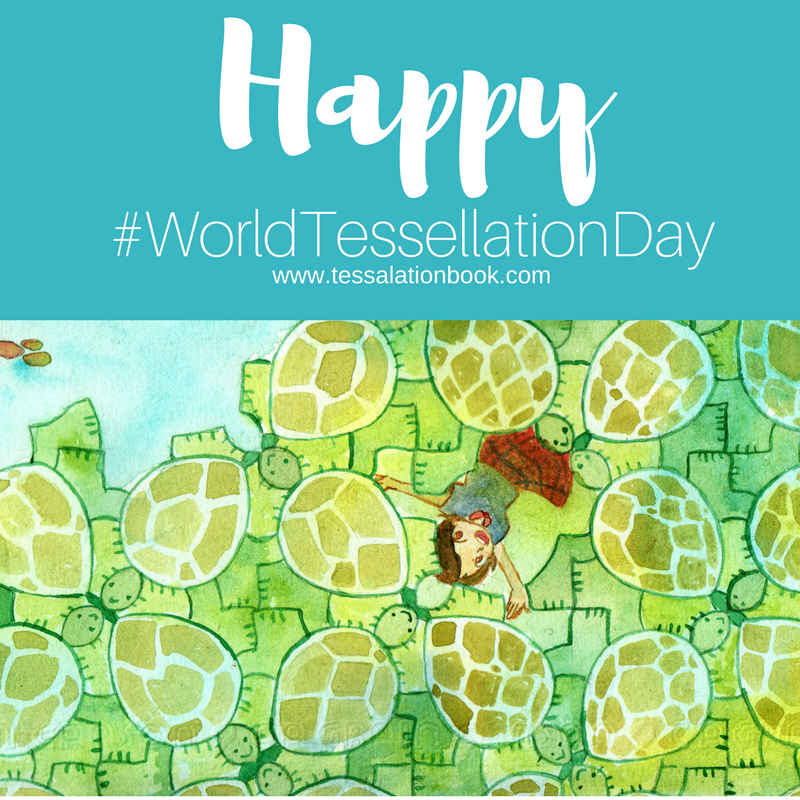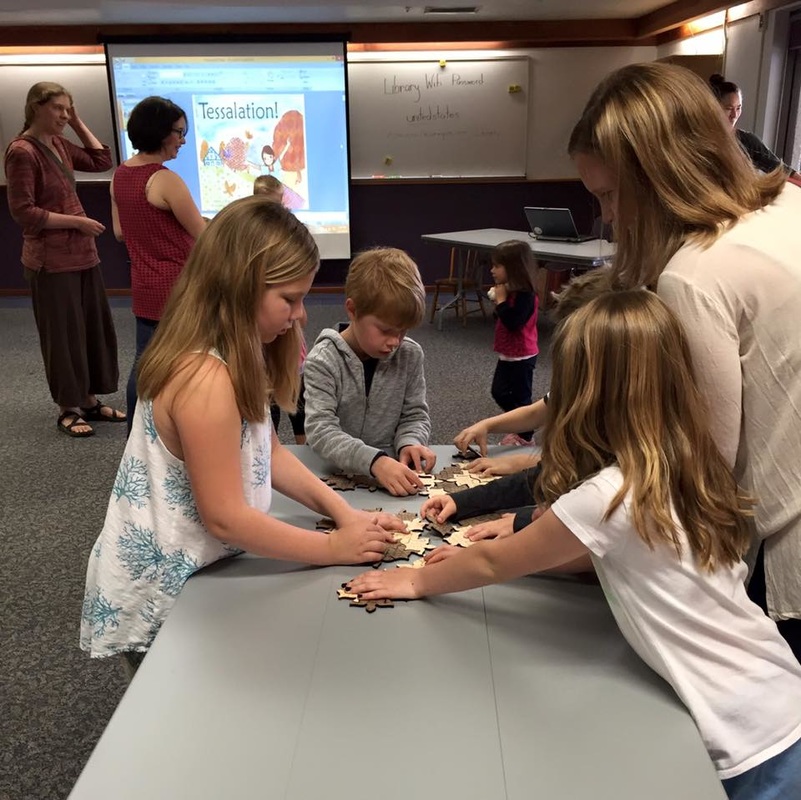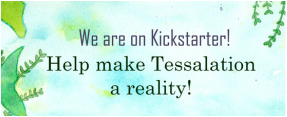Tessalation!
|
(If you're reading this, you've probably went looking for Tessalation! and noticed that you can't really find it anymore at any of the major retailers (or where it exists, it's posted for a couple hundred dollars). Tesslation! was a limited edition math picture book I published as part of a Kickstarter campaign in 2016. It's sold quite well, and I'm at the point where I'm considering a reprint. Until that happens, there are just a few copies left in my home. I'm happy to send them to you and have priced them at $10 since most of the people who want this book now are Waldorf teachers, math educators, or, most recently, nature centers who want to use it in educational programming. If you must have Tessalation!, please send me an email at [email protected]. Price will be $10 (I take Venmo) and I'll send via media mail, which is usually about $3.49. Thanks for loving on my little book.
2 Comments
Tomorrow is #WorldTessellationDay! I've put together these great images you can share to be a part of a global holiday. If you have the book, you can post an image of you or your kids reading it. Or DIY it and do your own tessellation. Use the #WorldTessellationDay hashtag and I'll find you!One of the great pleasures of writing my own math picture book has been new exposure to the genre and its must-have entries. So, for Christmas, my gift to you: A list of 10 great math picture books to give your creative kids at the holidays (and they are all creative kids!). What do you think -- are there any I missed? Read 10 Math Picture Books to Gift Children at the Holidays at the Math at Home blog.
I've been blogging over at Math at Home this month about Tessalation! and creative ways of exploring math. The latest post features a Q&A between me and Malke Rosenfeld, a dance instructor who brings innovative math learning into elementary classrooms with her program Math in Your Feet (TM). The work Malke and others are doing is important since it gives children a real context to learn math in -- and a fun one! Read the full Q&A with Malke Rosenfeld here.Here's the chapter rundown for the book I'm working on. Let me know if there is any other information you'd like me to cover in the book!Intro: A personal story of Kickstarter -- Why Kickstarter -- All about Kickstarter -- How Kickstarter has changed the game in publishing 1. “If you’re gonna do it, do it well.”
12. Giving your book a life beyond Kickstarter
Anything else you'd like to see in this title?It's true! I'm writing a book on How to Kickstart A Children's Book. I just finished the chapter on how to give your book a life beyond Kickstarter and I really can't wait to share it, so here's the chapter in its entirety! Giving Your Book a Life Beyond Kickstarter Congratulations! If you are ready for this chapter, you have a successful Kickstarter campaign behind you. Maybe you’re at the stage when you are shipping your rewards to backers and are looking forward to the publication of your book, or maybe you are already on top of your publication date. Either way, the bulk of the time-sensitive work related to your book is behind you. From now on, you can think of your book as a Passive Income Project. The product is already out, you have a committed group of early buyers who really love you and your book, and you are in the plum position of having some extra books to sell. You really, really want to get all of these books sold, right? Publication Day With traditionally published books, publication day is a big deal. You can expect to have a flood of orders when the book is available and readers who have been eagerly awaiting your output are primed for receipt of their books. Not so with Kickstarter books. With Kickstarter, your biggest fans have already received your book weeks if not months before the book’s availability. With your book, it’s going to be a quieter launch. You’ve already celebrated your campaign launch and your last day on Kickstarter. Have a publication day party might feel like overkill, expect to your biggest backers. But you can still do something. You can still have a quiet celebration with your family and send it out to all of your social media accounts. And you can involve your backers in other ways. If they have their books, you can invite them to post a picture of themselves reading with your book on social media. Or, you can ask them to do the most important thing a friend and backer can do. You ask for a review. Getting official reviews for your book Two traditional companies are well-respected within the book industry for their review programs: Publishers Weekly, the most important industry publication for the book world, and Kirkus Reviews, a well-respected book reviewing company that often provides the first reviews to hit the scenes. Publishers Weekly Publishers Weekly used to make a distinction between self-published and traditionally published reviews; for decades it was all but impossible to get a review for a self-published book in the industry pub. But as of 2014, it has launched Book Life, where self-publishers can submit their books for a chance to be considered by the publication. It’s pretty great. The site is easy to use and it is free. To sign up for Book Life, just go to the site. Only when your book is selected for review on PW Select will you be required to pay the $149 reviewing fee. If you do decide pay the fee to PW, you will receive a number of benefits. When you pay $149 to participate in PW Select, your book appears in: - Publishers Weekly's print and digital edition - the home page of PublishersWeekly.com - the home page of BookLife.com - BookLife's weekly email newsletter to 10,000 recipients - BookLife's Twitter and Facebook channels Plus you receive: - a six month digital subscription to Publishers Weekly - a one year digital subscription to Publishers Weekly's PW Select monthly supplement - a listing of your book in Publishers Weekly's special announcements database powered by Edelweiss which reaches tens of thousands of booksellers, librarians and reviewers - a free copy of the Publishers Weekly print issue in which your listing appears Is it worth it for you? The fee is relatively modest as far as marketing fees are concerned; however, if you have a book with a very niche market, you might do better reaching out to that market yourself rather than paying to swim in a sea of general interest. Kirkus Reviews Kirkus is a highly respected reviewing company known for sending out the very first reviews for when books are published. The company publishes about 10,000 reviews each year, and sends out the reviews to roughly 15,000 booksellers and other merchants. What’s even better? With Kirkus, indie books get the same level of consideration that traditionally published books do. That’s both good news and bad news. If you choose to engage with Kirkus, your book will be judged in comparison to the best in the industry, and the idea of being “Pretty good for a self-published book” isn’t going to hold much sway with its readers or reviewers. The bar is high. That having been said, having Kirkus in your corner can be a very, very good thing. The reviews that emerge are 250-300 words, written by an anonymous reviewer, highly considered, professional quality reviews. The cost for Kirkus reviews is $425 for 7-9 weeks and $575 for a rush delivery of 4-6 weeks. To get reviewed by Kirkus as an indie author, go to this site. Other book review sites Publishers Weekly and Kirkus are the big 2 official companies, but there are countless other sites you can submit your book to for review. My short-list includes: The Children’s Book Review Education Oasis KidsReads Through The Looking Glass Children’s Literature Kid Lit Reviews Note: Don’t pay for reviews. Ever. This is unethical and should make your soul feel like it’s being eaten slowly by bugs. Getting influencer reviews If you have been giving back to your backers throughout the campaign, paying very close attention to who is backing you, and why, then you will have a built-in list of influencers you can ask for reviews. Make no mistake: This is a big deal for them, too. Unless you are asking a celebrity who has a massive firewall around themselves, making it impossible to reach them, most influencers would be honored to have their blurbs appear on the back of your book and in your book’s promotional materials. This is especially true if they backed your project themselves. For my project, I had a number of creative math educators who supported the book’s publication. One, Christopher Danielson, of Talking Math with You Kids, even ordered 10 copies of the book. He, and three other people I highly respect, who speak to the audience I want to connect with my book in its afterlife (math educators), provided me with four blurbs for the back of the book. I have subsequently used them on websites, on promotional materials, on blog posts. I continue to give back to this group of people by helping them promote their projects, as they did mine. How do you ask? Well, as with all asking, first you get used to the idea. Asking works better if you’ve helped other people first. So first, I gave to them, letting my networks know about their products and offerings. Then, I sent them a quick email asking them to provide a blurb. Sample influencer email Dear [Influencer], I’m putting my final files together for [book’s title] and was wondering if you’d be able to provide a blurb for the back over. Nothing too complicated, just a sentence or two on what impressed you about it most. Thank you for considering. I know how busy you are and am reaching out because I know your voice would be meaningful to readers who pick up Tessalation!. Best regards, [Your Name] That’s the most important part -- their voice is meaningful. It truly is. Besides -- what can they say? No? Not now? Maybe never? Nothing at all? You’ll never know if you don’t ask. Every one of the influencers I ask to write a blurb wrote one for me, even though they are all super-busy professionals with families and jobs and dreams of their own. Even today, the back cover is my favorite page of the book. Not because I’m overly convinced of myself or my work (I’m not), but because I can see in those blurbs the relationships I’ve built throughout this process. These are truly awesome people and I couldn’t be more honored to have their names on my book. Getting Amazon reviews You aren’t done asking. Indeed, you are far from done asking. If you want your book to have some legs after birth, you’re going to have to ask backers to write you a review on Amazon and other sites where readers -- and book consumers -- congregate. I was sure this would be no big deal after the book was delivered. Wasn’t everyone going to jump at the chance to review my book, the one they paid $25 for, the one that fulfilled their basic human need for a book about tessellations wrapped in a stunning narrative form? In a word, no. In fact, I’ve had a moderately difficult time getting reviews for the book on Amazon. Why is that? I have a couple of theories.
Setting up a blog tour You’ve got your tribe of supporters -- known as backers in Kickstarter-land. They love your book (hopefully), they love you (if you’ve done things right). Some of them have a great way of accessing the audiences you’ve identified as important to your book’s success. Maybe this backer is an influencer who backed because your book addresses something important in their own crusade, wheelhouse or platform. Maybe they just have a really loud voice on social media. Check out their websites to see if they have a blog. Do they update it regularly? If you find that this backer is also a blogger, consider reaching out to him/her to join your blog tour! What’s a blog tour? A blog tour is when you have a different blog post something about your book for a distinct period of time. The amount of time you pick will be based on your own tolerance for posting, social media and your own stamina. Blog tours are great because they help you target the exact audiences who would be interested in your book. Instead your book appearing on any old blog -- say, a children’s book blog -- they appear on blogs with related content and audiences who are hungry for that content. Do it correctly and successfully and you will give your book a mighty launch into the world, one that is targeted, reaching the communities who naturally gravitate to your book’s subject. Here are some steps to launching a blog tour. Step 1: Identify appropriate bloggers. If you’ve done the audience exercise at the beginning of this book, you know that being as specific as possible about ideal readers helps your cause. Who are the bloggers who reach the audiences you want to reach? Make a list of 25 bloggers who might be interested in having a guest post from you or in blogging about your book. Make sure 5 of them are people who actually backed your project. Step 2: Create the scope of your tour How many blogs would you like to cover your book? How long do you want to do this? For my own blog tour, I picked 15 days, and 15 blogs. I wanted it to feel long enough to feel substantial but short enough to ward off my own blogging and social media fatigue. If you want a short tour, a week is good. A month might feel like overkill unless you have a GIANT project. Step 3: Make a list of guest posts you’re willing to write Some bloggers will want to write about your project themselves, others, especially the ones who post often, will be more likely to post if you offer them content yourself. Make a list of the types of stories you are willing to write about your project. Make sure that you have crafted the blog post idea with their audiences in mind. How are you going to do this? You are going to read half a dozen of their own blogs to get a sense for who their readers are. Also, you can ask the blogger about their readers! Here are some I did for my blog tour, having identified that I wanted to reach people in the creative math community, aka, math teachers: How to Introduce Tessellations to Elementary Students (using my book) DIY Tessellation Tutorial Q&A with the author of Tessalation! How to make tessellation cookies 10 Best Picture Books to Kick off a Themed Hike How to bring more creativity into the math classroom Those are just a few ideas. The options really are endless. The trick to making this work for you is to think a lot about how you can write this post for other peoples’ audiences. Step 4: Reach out to the bloggers You need to give people enough time to set this up, ideally, around a month or more. Send them an email introducing the tour to them and explain why you want their site to be a part of your tour (authentic flattery helps, here). Dear [blogger]: I’ve been following your blog for a while and have been impressed with how you [here, let them know what impresses you]. Now that my children’s picture book [name] has been successfully funded on Kickstarter, I am setting up a [amount of time] blog tour to help get the world out after the book’s publication. Would you be interested in joining the tour? I can write an appropriate guest blog for your site, or, if you’d like to write something yourself, I’d be happy to provide you with a PDF of the book and other images or materials. Here are some ideas I have: [list of topics you brainstormed] If you decide to write about my book and be part of the tour, I’ll send out the link to your site to all of my social media channels, including my own blog, Twitter followers, Facebook followers, and Kickstarter backers. Do let me know if you have time and interest and thank you so much for considering this. Best regards, [your name] Step 5: Follow up with them Answer their questions, focus on adding value to THEIR platforms and audiences, and make it easy for them. What do you do if people say no? You thank them anyway, you don’t take it personally and you move on to the next person on your list. If they say yes, you add their header and subject to your “Blog Tour” page of your website and you link to their site immediately. This lets both you and them know this tour is going to be legitimate. Step 6: Actually write the content For each of the bloggers on your tour, you are going to be 1.) Providing them with content or 2.) Helping them write their own. So you need to make sure they have everything they need to make this successful. If you are writing the post, get started NOW and write them as soon as possible so you’re not frantically trying to pull something together day-of. If they are writing the content, follow up about a week before it posts to see if there is anything more that they need. Things they might need:
Step 7: Post links when the tour goes live On the day the tour starts, make a big deal out of it and send out a blast to all of your audiences with the first links. Thank the blogger profusely, and tell the world what you love about their site. Give, give, give. As each day of the tour progresses, do the same for every new stop on the tour. Step 8: Thank them These bloggers are great. They are the hosts of their own parties and they let you be the star guest at their most recent one. You helped them, sure, but they helped you more. Be gracious. Be thankful. Send them a personal thank you for their part in spreading the word about your book. Even if they screwed the pooch and didn’t even get it up on time. Stuff happens. Move on. Be gracious. A final word giving your book a life What’s at stake here? Well, it’s nothing less than the continued success of your book across early-adopter audiences. Kickstarter is great for making THE THING for people, and for getting the momentum going on a project, but it’s only the beginning.This is not a definitive list of all the things you can do to market your book to readers. For further reading, I recommend Derek Murphy’s excellent Book Marketing is Dead: Book Promotion Secrets You MUST Know BEFORE You Publish Your Book. Are you excited to read more!?? I am thisclose to being done with this book and can’t wait to help more people be successful on Kickstarter!It is not possible to just sit back and watch the reviews roll in for your book on Amazon or any of the other book sites. You can't just expect people to take time out of their lives to post their experiences if you don't ask. How do you ask? Well, quite simply, you just ask. Asking is not begging. Asking is putting yourself in a position of vulnerability for a moment and detaching from the response. The good news? If you have put your book out by funding it on Kickstarter, as I did, then you have an entire list of backers you can turn to for the very delicate work of asking. I've started my own asking process recently, and it's beginning to pay dividends. A little over a week after being officially published, Tessalation! has 10 reviews on Amazon.com. Nearly every one of those reviews resulted from me asking someone who I know has the book. Simple language for asking for a review:HI! Was wondering if you would consider reviewing Tessalation! on Amazon.com for me. I'm trying to give it a life beyond the Kickstarter and would appreciate your voice. Then -- and this is the important part -- send them the EXACT LINK you need them to go to. DO NOT ever require them to find the book themselves. That is asking too much. Really. And then you do it again and again. Chances are good that if any of your friends or backers have enjoyed the book they have told you some stories about reading to their children or the moment they opened the package or the joy on their faces when they finally saw the final product. I highly recommend you ask them to regale these stories on Amazon or other sites to lend the critical authenticity to the reviews. See. It's as simple as this: Have you read Tessalation!? Would you consider reviewing it? Click here to review.For the final day of the Tessalation! blog tour I'm on Artful Maths, a gorgeous site devoted to origami, colorful mathematical play and the connection between math and creativity. Claudia did a stellar job linking to some of the other spots on the blog tour and pointing readers to some resources for connecting tessellations to paper-folding exercises. I encourage you to check it out. Modular origami is definitely a THING in some quarters and I'm excited to see how the book will inspire people to create 3-D works of art! Read the whole post on Artful Maths here.One of my favorite things about what Tessalation! has done is give adults with an interest and love of mathematics a book to teach their children about a mathematical concept. The math isn't in-your-face in Tessalation!, but kids should leave the experience knowing what a tessellation is and, possibly, being able to identify it in the world. On his blog The Math Less Traveled, Brent Yorgey writes about using the book as a jumping off point for creating tessellations. Read the full post on The Math Less Traveled here. |
AuthorEmily Grosvenor, author of Tessalation!, a children's book about tesselations and patterns in nature. Archives
October 2022
Categories |

















 RSS Feed
RSS Feed
